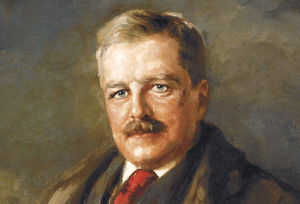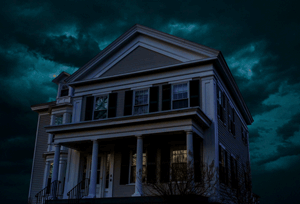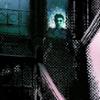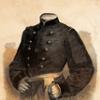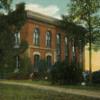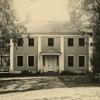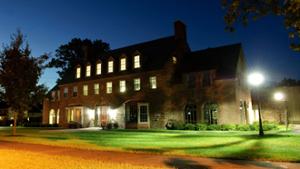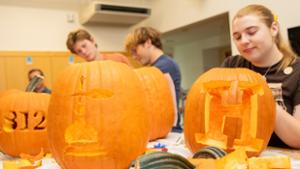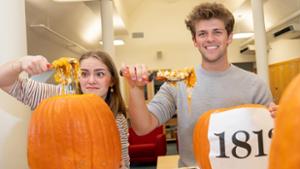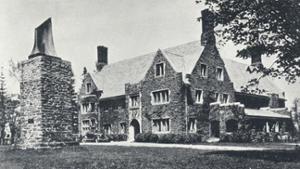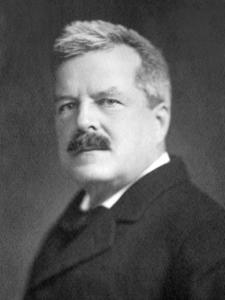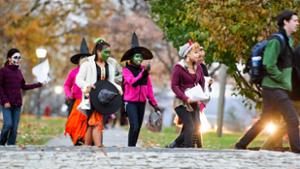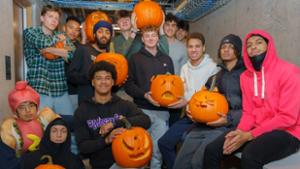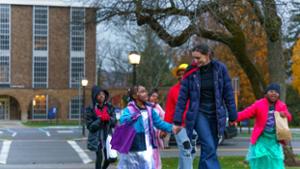
Haunted Hamilton
Hamilton is steeped in stories that history alone cannot explain. From a trio of floating sisters to a mystery mummy to spectral professors who never left campus, these ghostly tales linger like unanswered questions, suggesting that College Hill holds more secrets than it chooses to share. Scroll on … if you dare!
Tales from 100 College Hill Road
The house was built in the 1830s by William Anderson. He and his wife had seven children, including daughters Myra, Harriet, and Susan, all of whom never married. The maiden ladies spent their lives in the home, reputedly taking great pride in their distinguished residence and maintaining it meticulously. After Susan died in 1922 at age 95, the house became property of the College and home to faculty members.
Professor of English literature and Dean Frank Ristine became the first tenant, along with his wife, Katherine, and their children, Tom and Ann. For recreation, Frank kept a vegetable garden, which Katherine supplemented with a fine collection of flowers. The children attended the local one-room elementary school and later the central school in Clinton. It would be hard to imagine a more comfortable and content family than the Ristines.
Gradually, however, that began to change. The following is a slightly edited account from a document in College Archives titled “The Story of 100 College Hill Road.”
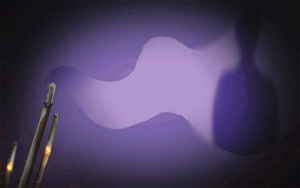
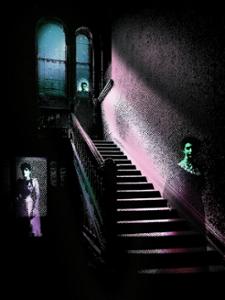
The Anderson Sisters
Late one night, while drowsy but undeniably awake, young Tom Ristine heard a distinct swishing of skirts in his room and then beside his bed. When he opened his eyes, he saw a woman’s form bending over him. She was tall and dressed in some dark color in a style he knew to be old-fashioned. Tom thought that, although it didn’t seem like her, the woman must have been his mother who had tiptoed into his room to make sure he was all right. Having finished her examination of the room and its contents, the woman approached the door and disappeared. She did not seem in any way frightening, so Tom felt more curiosity than fear.
When he reported this experience at breakfast the next morning, his mother, Katherine, said that she had not gone to his room. When Tom pressed her, she admitted that it might have been one of the Anderson sisters. She explained that she had long been aware that the three sisters were sharing the house with them. Katherine then described how they frequently moved from room to room and up and down stairs during the night, apparently making sure that the family was maintaining the house properly. Katherine assured her family that the sisters were good ghosts, and the children had no reason to be alarmed.
Unlike her mother and brother, Ann did not actually see any of the Anderson sisters — or “The Girls” as the family began to call them — but she frequently heard them with their swishing skirts moving up and down the stairs at night. She could hear footsteps and skirts grazing the steps and banister, but never the creaking sound associated with a sudden increase of weight on wooden steps. One night she heard a scraping noise above her head as if the sisters were moving boxes and trunks in the attic.
Frank’s attitude toward The Girls was ambivalent. Publicly, he scoffed at reports of ghosts, calling them “a lot of malarkey.” There was no way he would allow unworldly creatures a place in his practical universe.
Then, one summer weekend in the ’30s, Katherine and the children returned home one evening from their summer cottage in the Adirondack Mountains only to find that Frank was not there. They discovered that the night before he had walked across the street to the faculty club with his pajamas in his briefcase in order to have supper and spend the night. Frank explained that he didn’t want the maid, Viola, to have to go to the trouble of preparing dinner just for him, but Katherine and the children suspected that his real reason was to avoid being alone with The Girls. On subsequent occasions when the rest of the family was away overnight, Frank ventured to the faculty club to spend the night.
The Ristines shared their home with a spectral family of three until Frank's retirement in 1952. They then bought a farmhouse two miles further up College Hill, leaving the big white house. Their departure marked the end of its glory days. For a couple of years it stood empty while the College administration decided how to use it. During that time, the house became somewhat rundown. The lawn grew too high, weeds appeared in the walk, and paint began to peel off the pillars.
By the time the carpenters, electricians, and plumbers began to divide it into three faculty apartments, The Girls had gone. At least, the new tenants reported no sightings of them.
Editor’s note: Or did they? Read on …
A Witch Doctor to the Rescue
Jascha Kessler, a professor of English and modern literature at UCLA, wrote the following letter published in the Nov. 11, 2006, Financial Times:
From 1958 to 1961, we lived in the top half of a Greek Revival house that belonged to Hamilton College in upstate New York. When we moved in, the widow of the former chairman of the English Department came to tea and mentioned that the place was occupied by the ghosts of spinster sisters who had despised the college all their very long lives, and finally left their grand home to the nurse who cared for them for many years. She promptly sold it to the college.
Three years later I woke in the middle of the night and heard the floorboards creaking down the long hallway outside our bedroom. My hair stood on end — a first for me — and I lay a while, heart racing till those slow, heavy footsteps passed.
A month on there came hysterical shrieking at midnight from the room of our three-year-old son. When I rushed in, turning on a light, there he stood in his crib, crying out: “I don’t like that old lady! Tell her to go away!” I looked behind me where he pointed. No one was there — to my eyes. It took some time to get him back to sleep.
That sort of thing stopped when a colleague’s visiting sister, a health worker in Africa for the U.S. State Department, gave me some special dry herbs a witch doctor in Kenya had presented to her, and advised me to fumigate the rooms while commanding the old women to leave us alone.
Agnostic and rationalist though I was (and remain), I did just that. And we were left in peace afterward.
‘Doomed, Doomed, I Say …’
Listen as Winton Tolles, Class of 1928 and dean of the College (1947-72), channels the ghost of alumni past in this delightful 3-minute recording from a speech given to departing seniors in the 1950s. The voice heard at the beginning is that of Charles “Lafe” Todd ’33, professor of speech (1960-77).
The Headless Soldier
Ernest Williams, professor of biology emeritus, relays the following:
Soon after I arrived at Hamilton in January 1984, I heard stories about dissection having taken place in biology courses a century before on the body of a Civil War veteran, and that maybe the body was still in the building somewhere, perhaps in the attic. …
In the summer of 1988, the old ecology lab and office [located at the end of the second-floor hallway in the old Science Building] were renovated, and I had to clean out the old storage closet at the back of the lab so that it could be rebuilt as my research lab. In there, stashed in a corner, I found a cardboard box with a cadaver wrapped in plastic. The body had been cut into major sections, pickled in a preservative, and then taken out to dry, so there was no fluid, but it certainly retained the odor of the preservative.
The head was missing. It had also been very carefully dissected; all blood vessels, muscles, and nerves had been separated and freed, so it was a very nice specimen to look at for anatomical structures. It fit exactly the stories about the Civil War veteran, though I had no way to confirm that it was it. …
I didn’t want the body, and one can’t just throw a body in a dumpster, so I phoned the Oneida County Sheriff’s Office and said I had a body I had to get rid of. That made their day! Messages were flying back and forth by radio among law enforcement offices about my phone call. The Onondaga County Sheriff’s Office heard the messages and called me right away to say that they wanted the body for training purposes. I said, fine, they were welcome to it, and we arranged a time for them to pick it up. Three men from Syracuse came over on schedule to get it, and because I wanted to get rid of it — it seemed to me that possession was a problem — I made up a form for them to sign saying that they were taking full responsibility for it and that the body no longer belonged to Hamilton College. They signed it, and I filed the form.
I thought that was the end of it. Then two or three years later, I came back at the end of the summer from research out west to discover the rest of the story. The Onondaga County Sheriff’s Office no longer wanted the body, so that summer they returned it, not knowing or remembering that they signed the form taking possession of it. … Hamilton paid for the cremation.
Paging Nurse Connie
From “Morris: The New Kid on the Block,” an article by Sarah Rahman ’16 that appeared in the Sept. 3, 2015, Spectator.
When Morris House opened as a student residence in 2015, it marked the fourth chapter in the life of the building. Constructed in 1872 as the Hiram Perry Smith Library, the red-brick structure was transformed in 1924 into the Knox Infirmary before, nearly four decades later, serving as Minor Theater. Perhaps it’s Morris House’s proximity to the College Cemetery or its years housing the sick that led to stories about encounters with the supernatural.
According to the Spectator, “Allegedly, the dorm is haunted by a ghost named Connie, reputed to be dressed like a nurse. Students living here, however, have had their own experiences. ‘We heard someone walking in heels at six in the morning,’ says Amber Torres ’16, adding, “this place is haunted.’ Other residents shared similar stories of hearing doors open and close with no cause as well as tales of cats meowing in the night. A less eerie but still fun fact about the new dorm is that dryers operate for 99 minutes, not the typical 60 minutes like the dryers in other dorms.”
Haunting After Hours
Since the woman did not seem to notice her, Dennison decided to head home and attributed the experience to imagination. It wasn't until several months later, when Jeannie Greene, a records clerk who worked in that space, mentioned the “ghost who lives here” that Dennison allowed herself to think she may have seen that very same ghost.
She never saw the stranger again. However, she always wondered if the mysterious woman was connected to the Root family, who called the building home for a little over 100 years beginning in 1850. Prior to that, the building had served as Lee’s Tavern since 1804.
There are also rumors of a ghost in Buttrick Hall, Dennison said. People have heard strange noises coming from the attic — “the kind that are startling enough that you don’t want to go up to investigate,” she added.
Hamilton Ghosts in TV & Film
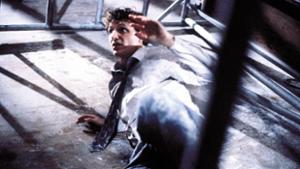
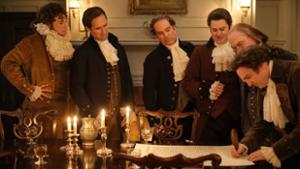
As a student, Edward Fitch, Class of 1886, was a charter member of the Emerson Literary Society, located in what is now Sadove Student Center at Emerson Hall. Known affectionately as “Little Greek” due to his extensive background in the classics, Fitch remained devoted to his alma mater, serving as professor of Greek from 1889 until his retirement in 1934.
Fitch’s status as “house father” compelled Catherine Toney ’92, J.P. Plumez ’93, and several other ELS members to reach out to their forefather in the early 1990s. They claim that they contacted Fitch during a séance at his resting place in the College Cemetery.
In addition, some claim a knock often can be heard on the ELS side door, likely the perpetual haunting of old Fitch. Once, during a heated political debate among house members, the sunroom doors flew open. There was no sign of a breeze, and the members’ only explanation was that Fitch was expressing his disapproval of the dissension within the house.
“On the third floor of the hall, it’s been said that a messenger from the Revolution walks down the hall. Numerous times, it’s been reported to stop and point at the ‘trespasser’ before moving on, disappearing through the wall.”
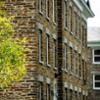
The Case of the Missing Mummy
According to a Case Submission Report filed in the New York State Troopers Scientific Laboratory on Jan. 29, 1962:
“NY telephone repairmen Gene Baister and Thomas Appler, Utica, NY, were stringing telephone wires in attic of the science building, Hamilton College, Clinton, NY, and discovered a mummified human head in a box. Investigation at college with Professors and Dean indicate that head is not from their collection, and where it originated, its sex, age, and how it got into the attic of the building is unknown. One theory is that it was used as a fraternity joke and then discarded.”
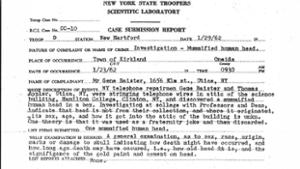
The police called in the New York State Museum for assistance. Said Charles Gillette, associate curator of archaeology, “I’m quite sure it’s an Egyptian head from about 1300 B.C. The treatment of the skull has all the attributes of that period — the New Kingdom. That’s not really my field; my specialty is American Indians. But I’m reasonably sure. And I’d say it’s a female.”
Gillette later reviewed his analysis with Eric Young, assistant curator in the Department of Egyptian Art at the Metropolitan Museum of Art, who similarly concluded that the mummy is most likely Egyptian, between 1500 and 1000 B.C.
Further investigation on campus revealed additional, although incomplete, background information. The skull had been given to Hamilton around the turn of the 19th century. Then it disappeared from 1908 until 1929, vanished again in 1933, was recovered a few years later, and then departed in 1943.
In its April 14, 1962, meeting, Hamilton’s Board of Trustees authorized placing the mummified head on permanent loan to the state’s museum in Albany.
Brothers of Sigma Phi claim they hosted the ghost of Melancthon Woolsey Stryker, Class of 1872 and president of Hamilton from 1892 to 1917. During the summer of 1986, two men from the Class of ’87 and Randy Fields, then the cook for Sigma Phi, conducted a séance on the stairway of the Sigma Phi house, now the Siuda House, home to the Admission and Financial Aid offices.
One evening, during a blue moon (the second full moon of the month), the three were supporting a heavy wooden tabletop on their laps when it began to shake. Then they placed the last Sigma Phi demitasse cup and saucer and the 1899 Hamilton yearbook, which was dedicated to Stryker, on the table. Fields explained that, “the table began to elevate and then it suddenly crashed against the wall across the hallway.”
It was a frightening experience for all of them. “We don’t care if anybody believes us, but we know what happened,” Fields said.
Trick-or-Trust Treat
Each Halloween, Hamilton hosts hundreds of Utica-area children — witches, superheroes, and fairy princesses all looking forward to a fun evening of trick-or-treating.
Trust Treat was established by the Class of ’92 in memory of Eric Trust, a member of the class who died unexpectedly on Halloween during his first year on campus. Fr. John Croghan, former Newman Chaplain, said, “In his short time at Hamilton, Eric’s openness and concern for others touched many people’s hearts. It is in that spirit that we sponsor this event as a chance for all of us to join together and provide a safe and happy environment for children to trick-or-treat.”
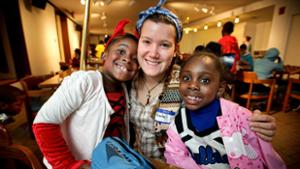
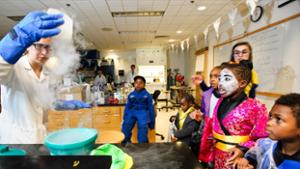
Demon Be Gone
Soon after the death of Professor of Mathematics Marcus Catlin, his widow, Philena, received an unexpected surprise. As is reported in Aug. 2, 1856, by the bulletin Age of Progress, her deceased husband “manifested himself to her, assuring her that he was not dead, but still lived, and was ever with her, to comfort and counsel — to aid her in the arduous task of guiding their dear children to an elevated home in the skies.”
Mrs. Catlin was so thrilled that she immediately notified the pastor at her Congregational church to share the news. To her surprise she was instead met with disgrace and labeled a Spiritualist. Two official letters of admonition were issued from the clergy: “The idea of communications with the dead, is a sad delusion,” noted the first in April 1856. “We hold the belief in communications from the spirits of the dead, to be contrary to scripture, to be useless, and altogether dangerous,” said the second letter a month later.
Mrs. Catlin severed her ties to the church and presumably continued her communications with the beyond. At some point, however, those efforts turned from comforting to frightening. On Jan. 3, 1855, she wrote a letter to A.B. Child, M.D., which was published in the May 21, 1859, edition of Banner of Light.
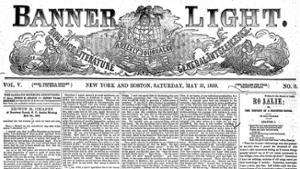
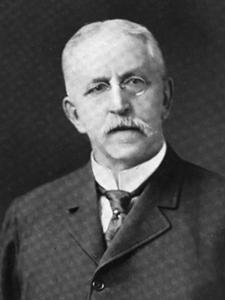
Dr. Child – Dear Sir: Be not surprised that a stranger addresses you, for I am compelled to do so from great necessity. I am the widow of Prof. Catlin, late Professor of Mathematics and Astronomy in Hamilton College, of this place. About two months since I was developed a medium. In a day or two after, two of my daughters and a niece were also developed. For a time, no one sat in the circle with us, except Mrs. Prof. Avery and two other female friends. At length, by the earnest request of a student, who is a loose young man, he was admitted to our circles, since which time two of our circles are at times unmanageable, from the influence of dark spirits; and to prevent them from self-injury and destruction, we are obliged to keep a constant watch over them. The influence is upon them almost without cessation, and we have been kept up to watch over them for many nights. Over one of these children — my daughter, who is about fifteen years old — these spirits have gained such perfect control, that the spirit of my husband, who controls the manifestations through my mediumship, influences me to write this letter to Dr. Child, of Boston, a person unknown and unheard of by me. Through another medium, also, not controlled by dark spirits, he desires the same. He says: “Write to Dr. Child, of Boston, and beg of him to come immediately and rid you of these great afflictions. He is a stranger to you all, but he is not a stranger to the spirits who now write. He possesses the power, and will immediately come and cause these dark spirits to leave you. Should he not come, those two children will soon be past control, and the consequences will be disastrous.”
It is a great favor to ask of you, a stranger; but the spirit of my husband assures me that you are enlisted with those who are laboring for the sufferings of humanity, and that you will come to the relief of these two children, and save them from ruin. …
In his lengthy account that followed the letter, Dr. Child described the subsequent trip he and a colleague made from Boston to Clinton to meet Mrs. Catlin and her family. It wasn’t long before he understood the situation was indeed not a hoax as he had feared. Instead, he found that the young daughter did appear to be possessed by a dark spirit. He described her as follows:
“From her innocent lips came curses and oaths, which were emphatic and profuse; her mouth frothed, and at times the spirit hissed like a serpent; her soft eyes, mild in expression, became like balls of fire; her features were contorted; her muscles were tense and powerfully exercised.”
Dr. Child further told of how he convinced the dark spirit that his intentions were pure and driven by love. “We are of one great family,” he told the entity, “offspring of one eternal Parent, who have met, and hand in hand we must go on the journey of life.”
The spirit eventually acknowledged a friendship with Dr. Child and agreed never to return to the Catlin home. The two even sealed the deal with a handshake.

To pluck a blade of grass in the College cemetery is to pull a golden thread that leads deep into Hamilton history, conjuring the service of women and men who have shaped an institution that is striding assertively into its third century. Yet common is the alumni refrain: “I lived here for four years and never even knew the cemetery existed.”

It All Started Here: 50 Innovations, Discoveries & Inventions Hamilton Has Given the World
If you’ve ever binged a favorite show on Netflix, sunk your teeth into a Manwich sloppy joe, or marveled at a photo captured by the Hubble Space Telescope, you can thank a member of the College Hill community.
